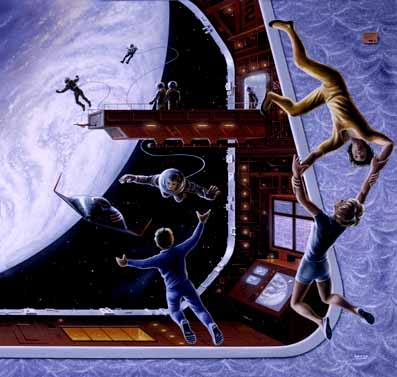The travel agents do not yet offer vacationers on the moon or romantic flights in the sky of Mars. But suborbital flights, orbital flights and space hotels are only a small part of the ambitious plans for future space tourism
Yoram Ored, Galileo

Direct link to this page: https://www.hayadan.org.il/tourism210405.html
How much longer will we have to wait until space tourism is relatively widespread? Not much according to management consulting agency Futron. According to the people of Potron, by the year 2021 the rate of tourism going into space will reach a rate of no less than 12 thousand space tourists in suborbital space flights (space flights that do not complete a complete circle around the Earth). Even then, unfortunately, only the rich among us will be able to win such a space flight. The drop in the prices of tourist space flights will be quite dramatic by then, but the price will still be very high - 50,000 dollars.
At the same time as the sub-orbital tourist space flights, there are already thoughts of starting the execution of orbital space flights, flights for a complete circle of the earth. Orbital flight turns the spacecraft into a satellite and it is able to move around the Earth further and further. For a sub-orbital space flight, like the one demonstrated last year by SpaceShipOne, a speed of a few Machs is enough when entering orbit (Mach is a speed of about three hundred meters per second).
2008: Touch the sky
The spacecraft Space Ship One, built by Brett Rutan, entered its orbit at a speed of Mach 3. On the other hand, in an orbital flight (a flight for a complete circle of the Earth), a spacecraft must be given a speed of Mach 25 upon entering its orbit. In the opinion of Jim Benson, who is the head of the company SpaceDev, which developed the engine of Spaceship Van, it is possible to send a tourist spacecraft for an orbital flight around the Earth as early as 2008.
However, orbital flights for a complete circle of the earth are not the end of the story. Hotelier Robert Bigelow is already planning space hotels. To build these he relies on an abandoned NASA space program called TransHab. Transaheb is a cell designed to inflate in space and provide a place to live. Bigelow's plan is to build an inflatable cabin that will be named Nautilus.
The Nautilus, after being inflated, will provide a volume of 330 cubic meters for the living quarters of future space tourists. The thickness of the sides of the Nautilus will be about thirty centimeters and it will be made of Kevlar, one of the strongest materials in the world, which is used, among other things, to build protective vests. The strong sides will provide partial protection from the impact of micro-meteorites moving in space as well as from space debris. Bigelow's engineers are now testing the strength of the Nautilus by firing fast projectiles at her.
Leather, tendons and kevlar
The Nautilus cells could be used as individual hotel cells floating in space, or alternatively they could be connected through a docking mechanism to create a large array of hotel cells that would constitute a real hotel.
When will we be able to witness these floating hotels, proposed by Bigelow? Well, Robert Bigelow intends to launch the first hovering hotel cabin in 2008, the very same year that, according to Jim Benson of SpaceDev, it will be possible to send the first tourist spaceship on an orbital flight around the Earth.
Seems like a successful combination of events. It will allow at once the transportation of tourists to the coffee route and their accommodation in suitable space residences. All we have to do is wait for 2008 to see if this combination will really come to fruition.
Space tourism expert
https://www.hayadan.org.il/BuildaGate4/general2/data_card.php?Cat=~~~140120266~~~85&SiteName=hayadan
